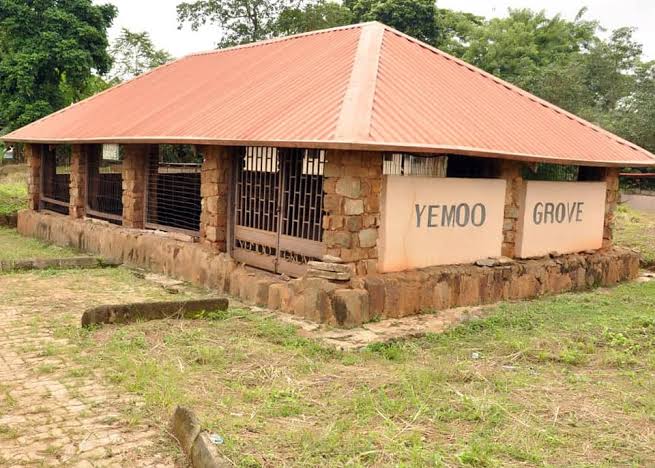QUICK SUMMARY: Ita Yemoo (Yemoo Grove) is an archaeological locality inside the ancient city of Ilé-Ifè (Osun State, Nigeria) that has produced important material evidence, metalworks (brass/copper alloy), terracotta, potsherds, and structural traces that linking it to the flourishing medieval Ife cultural and artistic tradition. It has been the subject matter of rescue excavations in the late 1950s–1960s and is included in recent multidisciplinary research programs investigating urban life, craft production and landscape at Ile Ife.
HISTORICALLY BACKGROUND (archaeology & research): Early discovery and rescue excavations–The site first became archaeologically prominent after chance discoveries of metal artifacts led Frank Willett and colleagues to “rescue” excavations at Ita Yemoo in 1957–58 and follow-up campaigns through the early 1960s. Those excavations recovered are rare brass and copper-alloy objects and other materials that helped define Ile Ife’s medieval artistic achievement.
Later and contemporary research–Ita Yemoo has been revisited in more recent projects such as the Ife–Sungbo archaeological program (focused on urbanization, domestic life, and archaeobotany) and targeted geophysical and excavation work (including integrated resistivity/magnetic surveys) that aimed to map subsurface remains and better understand site organization, pavements, and craft areas. These projects situate Ita Yemoo inside broader attempts to reconstruct Ife’s urban form and economy.
Chronology and cultural context–Findings from Ita Yemoo and neighboring excavated loci at Ife contribute to a picture of intense artistic and craft production at Ife during the medieval period (roughly the 11th–15th centuries CE in many discussions), when Ife was a major center of Yoruba cultural, religious and political life. Excavated metal sculptures and terracottas are often stylistically linked to the town’s celebrated naturalistic heads and figures.
LOCATION AND PHYSICAL DESCRIPTION: Where it sits–Ita Yemoo / Yemoo Grove is located within Ilé-Ifè (Ife Central area), Osun State, southwestern Nigeria, part of the dense cluster of archaeological and sacred spaces inside the historic city. Modern archaeological maps and geophysical surveys place the site amongst the groves and earthworks that dot central Ife.
What is there physically–Excavations and surveys at Yemoo have documented pavements composed of potsherds, beneath some places a stone pavement; concentrations of metalworking debris and finds; and buried features visible to geophysics (resistivity/magnetics). The site is a grove setting in places, consistent with the presence of sacred or ritual groves in Ife.
IMPORTANCE (archaeological, cultural, scientific): Archaeological significance–Ita Yemoo is a key locus for understanding Ife’s craft production (especially metalworking) and spatial organization. The metal objects recovered there (and in associated Ife contexts) rank amongst the West Africa’s most famous medieval sculptures for their technical skill and realism. The site helps archaeologists reconstruct urban life, craft specialisation and trade links in pre-colonial West Africa.
Cultural heritage value–As part of the wider complex of Ife archaeological and sacred sites, Yemoo is embedded in the living memory and spiritual geography of the Yoruba people, Ile Ifè is widely regarded as the traditional birthplace of humanity in Yoruba cosmology, and many groves and shrines remain culturally important. Preserving Yemoo thus preserves both scientific data and intangible heritage.
RELEVANCE TO THE PEOPLE OF ILE IFE: Identity and memory–For residents of Ile Ife, archaeological places such as Yemoo are not only “sites” for scholars but are interwoven with myths, ritual life, and the city’s identity as ancestral homeland of the Yoruba. Objects and findings at Ife feed directly into local pride and global recognition of Ife art.
Museum and educational links–Many objects from Ile Ife contexts are curated by the Ile Ife National Museum and other institutions; these museums and the research projects create opportunities for local education, school visits, and cultural programming that strengthen the connection between archaeology and community.
PERSONALITIES AND SCHOLARS ASSOCIATED WITH ITA YEMMO: Frank Willett — conducted the important rescue excavations at Ita Yemoo in 1957–1963 which brought the site to international archaeological attention.
Gérard L. F. Chouin — Co-director of the Ife-Sungbo Archaeological Project and author/reporter on excavations and program reports for Ile Ife projects (recent field seasons).
Researchers in geophysics and local archaeology including scholars such as Akinola Shola Akinwumiju and project teams have run integrated geophysical studies at Yemoo to map buried features and inform excavations.
TOURIST PONTIALITIES AND VIABILITY: Ita Yemoo has strong potential as part of an integrated cultural heritage tourism offer in Ilé-Ifè. Below are practical points and recommendations:
WHY IT CAN ATTRACT VISITORS TO ILE IFE: Unique archaeology & art context–Tourists drawn to African history and art will be interested in visiting the places that produced Ife’s famed sculptures.
Proximity to other attractions–Ooni of Ife’s Palace, the Ife National Museum, traditional festivals, and sacred groves create a compact cultural circuit attractive to cultural tourists.
WHAT WOULD MAKE IT WORK (Recommendations):
1. Interpretive infrastructure–Clear signage, information panels explaining the archaeology (in English and Yoruba), mapped trails through the grove, and safe viewing platforms for sensitive areas.
2. Museum links–Coordinated displays at Ile Ife National Museum that contextualize finds from Yemoo with labeled photographs and reconstructions, plus QR codes linking to excavation reports.
3. Community-led activities–guided tours led by trained local guides, participation of traditional custodians, craft demonstrations, and small local-run visitor services (tea/refreshments, handicrafts).
4. Conservation & controlled access–Protecting fragile pavements and in-situ features by routing foot traffic, using raised walkways where necessary, and limiting invasive activities in the grove.
5. Events & festivals–Aligning visits with cultural calendar events (with permission) can give tourists authentic, respectful cultural experiences.
CONSTRAINTS AND RISKS: Conservation risk–Exposed pavements, fragile deposits, and metal finds require protective measures.
Interpretation gap–Without good signage or local information, visitors may not appreciate the site’s significance.
Infrastructure–Access roads, restroom facilities, and safety measures need investment.
CONSERVSTION, RESEARCH AND COMMUNITY ENGAGEMENT(practical steps):
1. Finalize site inventory & protection plan–Use geophysics (already applied at Yemoo) and targeted excavation to map vulnerable areas, then place protective coverings or designate no-go zones.
2. Digitize archival finds and reports–Make reports and images (e.g., Willett’s finds and Ife-Sungbo project outputs) accessible to the public and researchers while respecting museum custody rules.
3. Community archaeology & education–Train local youths as site stewards and tour guides; run school programs linking Ile Ife’s archaeology to living culture.
4. Sustainable tourism plan–A small-scale, locally managed visitor program that feeds revenue into conservation and community projects.
RECENT AND ONGOING DEVELOPMENT(brief): The Ife–Sungbo project has continued fieldwork and publication activity into the 2010s and 2020s researching Ile Ife’s urban history and archaeobotany. Recent seasons and communications by project directors indicate renewed excavation and survey work at Ita Yemoo in the 2010s–2020s. Integrated geophysical surveys published (2015) and field seasons reported as recently as 2025 show active scholarly interest in the site.
SUGGESTED SHORT ITINERARY FOR A CULTURAL VISITOR TO ILE IFE(that includes Yemoo):
1. Morning–Visit Ile Ife National Museum (orientation to Ife art).
2. Mid-morning–Guided visit to Ita Yemoo / Yemoo Grove, explain archaeological layers, pavements and metalworking evidence.
3. Lunch–Local cuisine in Ile Ife town.
4. Afternoon–Ooni’s Palace area and tours of other groves/shrines (with permission, respectful observation).
5. Optional–Attend a local cultural performance or craft demonstration.
FINNALLY: Ita Yemoo (Yeemo/Yemoo Grove) is more than an archaeological locus, it is part of Ilé-Ifè’s living cultural landscape. Protecting the site, linking research with community knowledge, and building small-scale, respectful tourism could preserve its scientific value, while offering economic and educational benefits to Ife residents. Ongoing research (fieldwork, geophysical surveys and museum curation) continues to refine our understanding of Yemoo’s place in the extraordinary story of Ife’s m
edieval urbanism and artistry.





